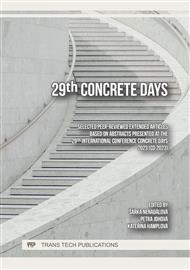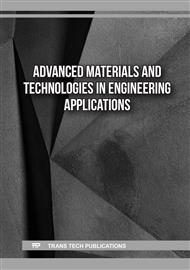[1]
Brandt, A.M. Fiber reinforced cement-based (FRC) composites after over 40 years of development in building and civil engineering.Compos. Struct. 2008, 86, 3–9.
DOI: 10.1016/j.compstruct.2008.03.006
Google Scholar
[2]
Lantsoght, E.O.L. Database of Shear Experiments on Steel Fiber Reinforced Concrete Beams without Stirrups. Materials 2019,12, 917.
DOI: 10.3390/ma12060917
Google Scholar
[3]
Marcalikova, Z.; Cajka, R.; Bilek, V.; Bujdos, D.; Sucharda, O. Determination of Mechanical Characteristics for Fiber-Reinforced Concrete with Straight and Hooked Fibers. Crystals 2020, 10, 545.
DOI: 10.3390/cryst10060545
Google Scholar
[4]
Sucharda, O.; Marcalikova, Z.; Gandel, R. Microstructure, Shrinkage, and Mechanical Properties of Concrete with Fibers and Experiments of Reinforced Concrete Beams without Shear Reinforcement. Materials 2022, 15, 5707
DOI: 10.3390/ma15165707
Google Scholar
[5]
Katzer, J.; Domski, J. Quality and mechanical properties of engineered steel fibres used as reinforcement for concrete. Constr. Build. Mater. 2012, 34, 243–248.
DOI: 10.1016/j.conbuildmat.2012.02.058
Google Scholar
[6]
Marcalikova, Z. Sucharda O. Modeling of fiber-reinforced concrete and finite element method (2021) International Review of Civil Engineering, 12 (1), p.11 – 19. (2021)
DOI: 10.15866/IRECE.V12I1.18636
Google Scholar
[7]
Cajka R.; Mynarcik P.; Neuwirthova Z.; Marcalikova Z.; Kropacek M. Tests of fiber reinforced concrete composite slabs on the subsoil with horizontal load (2020) International Journal of GEOMATE, 18 (69), p.143 – 150.
DOI: 10.21660/2020.69.9461
Google Scholar
[8]
Sucharda, O.; Lehner, P.; Konečný, P.; Ponikiewski, T. Investigation of Fracture Properties by Inverse Analysis on Selected SCC Concrete Beams with Different Amount of Fibres. Procedia Struct. Integr. 2018, 13, 1533–1538.
DOI: 10.1016/j.prostr.2018.12.313
Google Scholar
[9]
Di Prisco, M.; Colombo, M.; Dozio, D. Fibre-reinforced concrete in fib Model Code 2010: Principles, models and test validation.Struct. Concr. 2013, 14, 342–361.
DOI: 10.1002/suco.201300021
Google Scholar
[10]
Fib Bulletin 65. Model Code 2010, Final Draft; International Federation for Structural Concrete (fib): Lausanne, Switzerland, 2012;Volume 1, p.350
Google Scholar
[11]
Rilem TC 162-TDF: Recommendations of RILEM TC 162-TDF: Test and design methods for steel fibre reinforced concrete: Bendingtest. Mater. Struct. 2002, 35, 579–582.
DOI: 10.1617/13884
Google Scholar
[12]
RILEM (2011): About Rilem [Online]. Available online: http://www.rilem.net (accessed on 4 May 2022).
Google Scholar
[13]
BS EN 14651:2005+A1:2007; Test Method for Metallic Fibre Concrete—Measuring the Flexural Tensile Strength (Limit of Propor-tionality (LOP), Residual). British Standards Institution: London, UK, 2005.
DOI: 10.3403/30092475
Google Scholar
[14]
Kasagani, H.; Rao, H.C.B.K. The influence of hybrid glass fibres addition on stress—Strain behaviour of concrete. Cem. WapnoBeton 2016, 5, 361–372.
Google Scholar
[15]
Naaman, A.E.; Reinhardt, H.W. High Performance Fiber Reinforced Cement Composites 2 (HPFRCC2). In Proceedings of theSecond International RILEM Workshop, Ann Arbor, MI, USA, 11–14 June 1995; E & FN Spon: Ann Arbor, MI, USA, 1996.
DOI: 10.1007/bf02486203
Google Scholar
[16]
Sahoo, D.R.; Maran, K.; Kumar, A. Effect of steel and synthetic fibers on shear strength of RC beams without shear stirrups.Constr. Build. Mater. 2015, 83, 150–158.
DOI: 10.1016/j.conbuildmat.2015.03.010
Google Scholar
[17]
Gandel, R.; Jerabek, J.; Marcalikova, Z. Reinforced Concrete Beams Without Shear Reinforcement Using Fiber Reinforced Concrete and Alkali-Activated Material. Civ. Environ. Eng. 2023, 19, 348–356.
DOI: 10.2478/cee-2023-0031
Google Scholar
[18]
Bilek, V.; Sucharda, O.; Bujdos, D. Frost Resistance of Alkali-Activated Concrete - An Important Pillar of Their Sustainability. Sustainability 2021, 13, 473. https://doi.org/
DOI: 10.3390/su13020473
Google Scholar
[19]
Mateckova, P.; Bilek, V.; Sucharda, O. Comparative Study of High-Performance Concrete Characteristics and Loading Test of Pretensioned Experimental Beams. Crystals 2021, 11, 427
DOI: 10.3390/cryst11040427
Google Scholar
[20]
Information on: https://baumit.cz/produkty/betonove-smesi/baumit-proofbeton
Google Scholar
[21]
Information on: https://www.master-builders-solutions.com/cs-cz/produkty/masterfiber/ masterfiber-482
Google Scholar
[22]
ČSN EN 12390-3: Testing hardened concrete - Part 3: Compressive strength of test specimens.
Google Scholar
[23]
ČSN EN 12390-6: Testing hardened concrete - Part 6: Tensile splitting strength of test specimens.
DOI: 10.3403/30454320
Google Scholar
[24]
ČSN 73 1326: Resistance of cement concrete surface to water and defrosting chemicals
Google Scholar
[25]
ČSN EN 12390-8: Testing hardened concrete - Part 8: Depth of penetration of water under pressure
Google Scholar
[26]
ČSN EN 206+A2 Concrete – Specification, performance, production and conformity
Google Scholar



